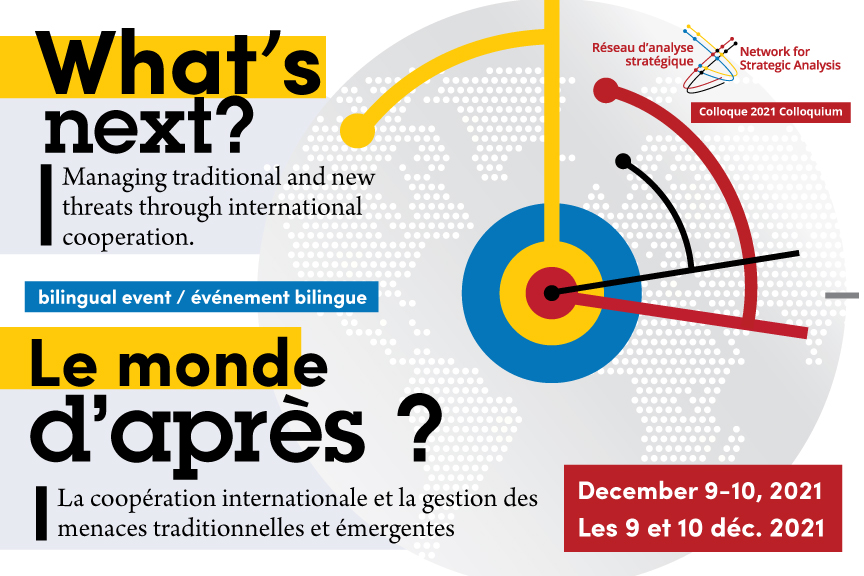Following its second annual colloquium, the Network for Strategic Analysis has produced the compendium “What’s Next? Managing Traditional and New Threats through International Cooperation.”
The theme of the second annual Network for Strategic Analysis (NSA) conference, held December 9-10, 2021, focused on transitions in international policy. At the outset, several countries have begun a post-pandemic transition, opting to ease public health restrictions. Throughout the year, our experts have noted the significant impact of COVID-19 on many security and defence activities, such as the operations of the Canadian Armed Forces in Canada and abroad.
Conversely, 2021 has also seen more pronounced and disturbing trends in great power competition and a weakening of democracy worldwide. It is clear that Canada must deal with an increasingly complex security environment. As noted in this compendium by Kerry Buck, Canada’s former ambassador to NATO, this environment has several challenges that have been exacerbated by the pandemic: “First, most countries have turned inward; second, democracy and social cohesion in many countries have been undermined; and third, the world order is becoming more unpredictable, with shifting power dynamics among key players and new sources of instability.”
Taking these major players into account, the increased competition between great powers narrows Canada’s room for manoeuvre as a middle power. By the end of 2021, Russia’s military presence near Ukraine’s borders was a concern. A few months later, China expressed its “unlimited” friendship for Russia, clearing the way for its February 24, 2022 aggression. The signs of this security downturn were visible at the conference, and last-minute diplomatic efforts, whether by President Biden or President Macron, bore little fruit thereafter.
Zachary Paikin’s article notes that these events place even greater constraints on Canada: “The narrowing of policy options now limits Canada’s ability to pursue its national interests, even as the international landscape has shifted from a gradual transition from order to outright instability and insecurity in the wake of Russia’s war of aggression against Ukraine.” Yet, Canada’s posture toward Ukraine is surely one of the few issues where foreign and defense policy had genuine strategic coherence. If, for years, we could question the effectiveness of a mission focused on military training in Ukraine, there is no longer any doubt as to the validity of this mission.
Similarly, Canada’s strategic alignment with NATO, and retreat from the UN, may have been the right move. However, the one area where Canada is still uncertain about its strategic direction is in the Indo-Pacific region. Although a Canadian strategy for the region is being developed, tough choices will need to be made given that Canada is not a power with global reach, despite the rhetoric that sometimes comes from Ottawa. Srdjan Vucetic furthers this point by stating that Canada’s commitments are difficult to reconcile with its means: “Indeed, the alliance burden-sharing promises Canada makes to keep the Indo-Pacific ‘free and open’ by definition affect similar promises made in other contexts – from NORAD modernization to NATO’s next Strategic Concept and the Climate Change Action Plan.”
At the very least, Canada must clarify its strategic orientations and make choices that are better aligned with the diplomatic, economic and military capabilities at its disposal. It is now necessary for Canada to identify who the main threats are, as its allies have done. Russia has removed any ambiguity about its status, but what about China? Identifying a threat contributes to greater strategic clarity. Beyond the threat posed by Russia, one of the first steps is to recognize, both at the governmental level and in the public sphere, that Canada is attacked below the threshold of war on a daily basis, whether in cyberspace or outer space. Indeed, the Canadian government can be counted on to provide clear direction in times of war but is unprepared for a crisis in the grey zone and the information domain. It must, therefore, improve its capacity for anticipation by clearly articulating its interests and priorities prior to crises.
Now that a defence policy review has been announced, the NSA will advocate for this process to open the door to real debate and reflection on Canada’s strategic direction, accompanied by public engagement, which should be heightened in the context of the war in Ukraine. The goal is to break down the walls within government between the political level and the public service, between political parties, and between government and academics, experts and the general public – a goal that is central to the NSA’s mandate.
An updated defence policy is also an exercise in public diplomacy, both internationally and domestic, signaling which foreign policy issues and objectives are important to Canada. As such, it is necessary to select issues Canada has a particular interest and comparative advantage in, to arrive at a coherent government-wide approach to Canada’s international engagement. There is a need to move away from a performative approach to international policy, as Canada has successfully done with the crisis in Ukraine. But in other regions, Canada’s engagement does not have such credibility. For example, if Canada decides to renew its engagement on the African continent, or in the Middle East, it must offer more targeted contributions by better understanding the diversity of local contexts.
It is also important to note that Canada is not immune to security threats on its own territory. On the contrary, it is increasingly the target of cyberattacks, requiring the mobilization of resources to protect critical infrastructure. Moreover, it is imperative to develop a new cybersecurity strategy, along with a reflection on the future of NORAD as part of an innovative vision to redefine continental defence. The investments are visible, and they were enhanced in the 2022 federal budget announcement, but they remain insufficient and are not supported by a coherent and clearly articulated strategic vision. Émile Lambert-Deslandes’ paper develops a range of questions to inform these reflections, including “what the relationship with the United States should be, whether [Canada] is prepared to invest in becoming a productive member of its alliances, and whether its values should be used as objectives of its international policy.” Answering these types of questions is a significant challenge to which the NSA can contribute, as it prepares for its third annual symposium on September 22, 2022.
Read the full version of the compendium here: Compendium – NSA Second Annual Conference
Table of contents
- “Introduction,” by Stéfanie von Hlatky and Justin Massie.
- “The Post COVID World (Dis)Order: A Playbook for Canada’s International Engagement for the Year Ahead,” by Kerry Buck.
- “From the Atlantic to the Pacific: A new strategic posture for Canada,” by Zachary Paikin.
- “China’s Hegemony and Canada’s Indo-Pacific Strategy,” by Srdjan Vucetic.
- “In Canadian International Policy, Real Change Means Hard Choices,” by Émile Lambert-Deslandes.






Comments are closed.